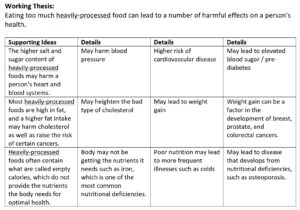
An idea matrix is a way to develop support once you have an idea of what you want to write about. An idea matrix for writing is just what it sounds like – it’s a table or grid that helps you identify, organize, and develop your ideas. You lay out your ideas in columns and rows, and fill details in the appropriate squares.
How to Create an Idea Matrix
Working Thesis: Write your topic and your assertion about that topic. Your thesis is a “working” thesis because you may find that you need to circle back and revise it as you develop your supporting ideas and details. The thesis and support need to relate directly to one another.
Supporting Ideas: In this column, insert main ideas that support your assertion in the working thesis. What would convince a reader to support your assertion? These ideas will eventually become your topic sentence assertions.
Details: In each row, insert details and ideas that further develop and exemplify each supporting idea group. Note that you do not have to fill up every square of the grid.

For example, here’s an initial idea matrix a writer developed to identify possible topic sentence ideas:

The writer’s next step was to add notes in each supporting idea row for examples and details to develop that supporting idea:

After adding notes, the writer assessed her idea matrix:
- She decided that she really didn’t have much to say about fiber, so she deleted that supporting idea.
- She realized that “history of heavily-processed foods” did not directly provide an idea that supported her assertion about harming health, so she deleted that concept.
- She realized that she needed to say more about fat intake, so she added more details in that row.
- She tweaked and added details overall.
- Then she turned her supporting ideas into topic sentence assertions to create the following revised idea matrix.

The writer may have two more iterations of this essay planning matrix:
- If she decides on a certain order for her information, she may decide to re-order the rows and tweak the working thesis to indicate a particular pattern of organization.
- If she decides to support some of her assertions with research, she might add rows under each topic sentence row to house appropriate quotations or summaries.
The final idea matrix, if the writer made these two changes, might look like this:


As you might have deduced, after working progressively with an idea matrix to plan your essay, it’s a relatively easy next step to draft that essay. An idea matrix helps you identify the “bare bones” – the skeletal structure of ideas in an essay that you then can develop with examples and details. It also helps you stay on track, since you can see at a glance if there’s an idea that doesn’t directly support the assertion in the working thesis, or that doesn’t fit with the other ideas.
Here are two templates that you are welcome to download and adapt to help you write:
Idea Matrices in Other Contexts
Just as a note: Idea matrices are used in many other contexts. The following video focuses on generating ideas in a business to engage consumers. Although the context is different, you’ll see the process of using a matrix to generate ideas is the same.
Candela Citations
- Idea Matrix for College Writing. Authored by: Susan Oaks. Project: College Writing. License: CC BY-NC: Attribution-NonCommercial
- image of a matrix with colored tiles. Authored by: David Zydd. Provided by: Pixabay. Located at: https://pixabay.com/illustrations/square-background-color-mosaic-2724387/. License: CC0: No Rights Reserved
- video Design Thinking: Using an Idea Matrix. Provided by: Skillsoft YouTube. Located at: https://www.youtube.com/watch?v=HwGRc3VrBmY. License: Other. License Terms: YouTube video